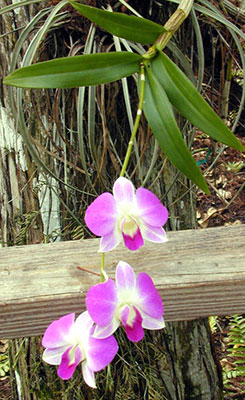Orchids

Most orchids need to be repotted every few years, and many can be divided into smaller plants. Orchids typically prefer at least partial shade or filtered sunlight, and should be protected from cold temperatures.
Orchid Potting Media
Most orchids are epiphytes and they need special media in which to grow.
Some of the most common ingredients in commercially available orchid mixes are chopped tree fern fiber, chopped fir tree bark, osmunda fiber, charcoal, and volcanic rock. These materials all help to create the loose, well-drained environment that orchids crave.
Choose from containers made of plastic, clay, wire, or redwood. Some orchids can be mounted on a piece of cork or other bark. Every two years or so you’ll need to replace the orchid growing media for each of your plants.
Repotting Orchids
Orchids should be repotted when the media breaks down or the plant gets too big for the pot. You’ll use the same procedures when you want to divide an orchid to create a new plant.
To repot an orchid, first remove the old media, as well as any dead or diseased roots before placing it in the new pot or on the new mounting. After repotting, use clips to secure the orchid until it’s established. Water your plant right away, but don’t fertilize for at least several weeks.
Why Won’t My Orchid Bloom?
One of the biggest mysteries for some gardeners is why their orchids won’t bloom. If your orchid sits in a dark corner, try moving it closer to a windowsill. Most orchids prefer bright, indirect light and won’t bloom unless they’re getting it.
Next, think about how you fertilize. Orchids need nutrients, but applying too much fertilizer can inhibit blooming. Consider how old your orchid is. Some orchids won’t bloom until they’re at least five years old.
Also, many people aren’t aware that most orchids need a 15- to 20-degree difference between day and night temperatures in order to flower.
Orchid Pests and Diseases
The most common orchid pests are scale, mealy bugs, thrips, and mites, especially if you’re growing orchids as houseplants.
You can treat small pest problems on some orchids by dabbing the pests with a cotton swab that’s been dipped in rubbing alcohol. For larger infestations, you can wash the plants with water or use a horticultural oil or soap spray that’s safe for use on orchids. You may need to repeat this process to get the pests in check.
If the pests still won’t go away, you can search for a stronger insecticide that’s safe to use, though you should always start with the least toxic products first.
Orchids that are suffering from a disease may show symptoms like streaks, blotches, or even crinkling on their leaves, roots, or flowers. If you suspect a problem, the first step is always to isolate sick plants so that the pathogen can’t spread to healthy plants.
With some diseases, you can remove the affected tissue with a clean knife and then treat the orchid with an appropriate bactericide or fungicide. In other situations, the best strategy is to dispose of the infected plants.
Cut down on future disease problems by creating a healthy growing environment and practicing good sanitation. Provide good air movement, avoid getting the foliage and flowers wet, and always use clean tools when transplanting and propagating your orchids.
Remember to check your orchids often so that you can take action before small problems from become bigger ones.
Also on Gardening Solutions
More from UF/IFAS
- Boisduval Scale, Diaspis boisduvalii Signoret
- Florida Plant ID: Dendrobium Orchid
- Florida Plant ID: Moth Orchid
- Management of Orchid Pests with Silwet® L-77 and Horticultural Oils
- Orchid Pollination Biology
- Terrestrial Orchids for South Florida (PDF)
